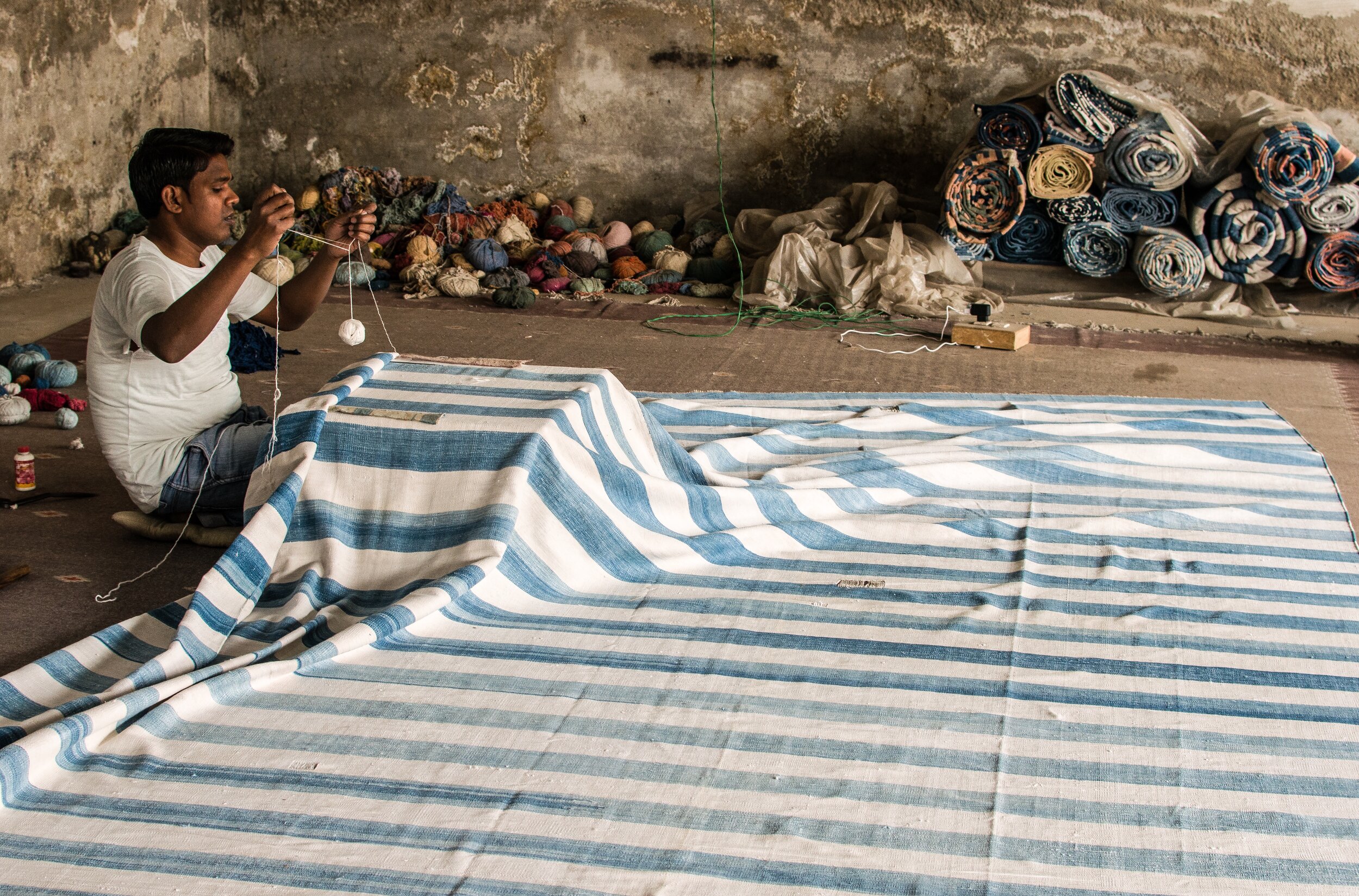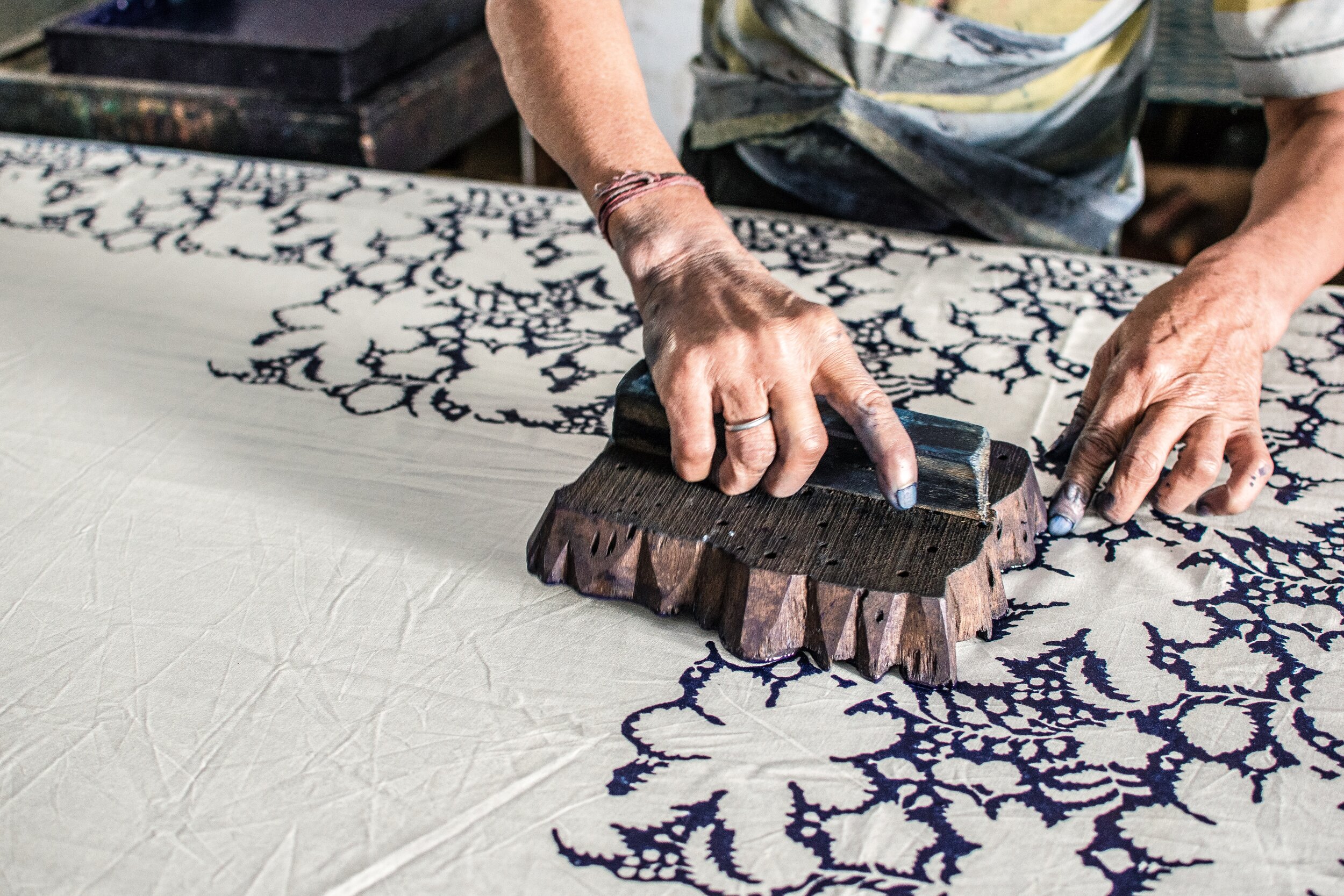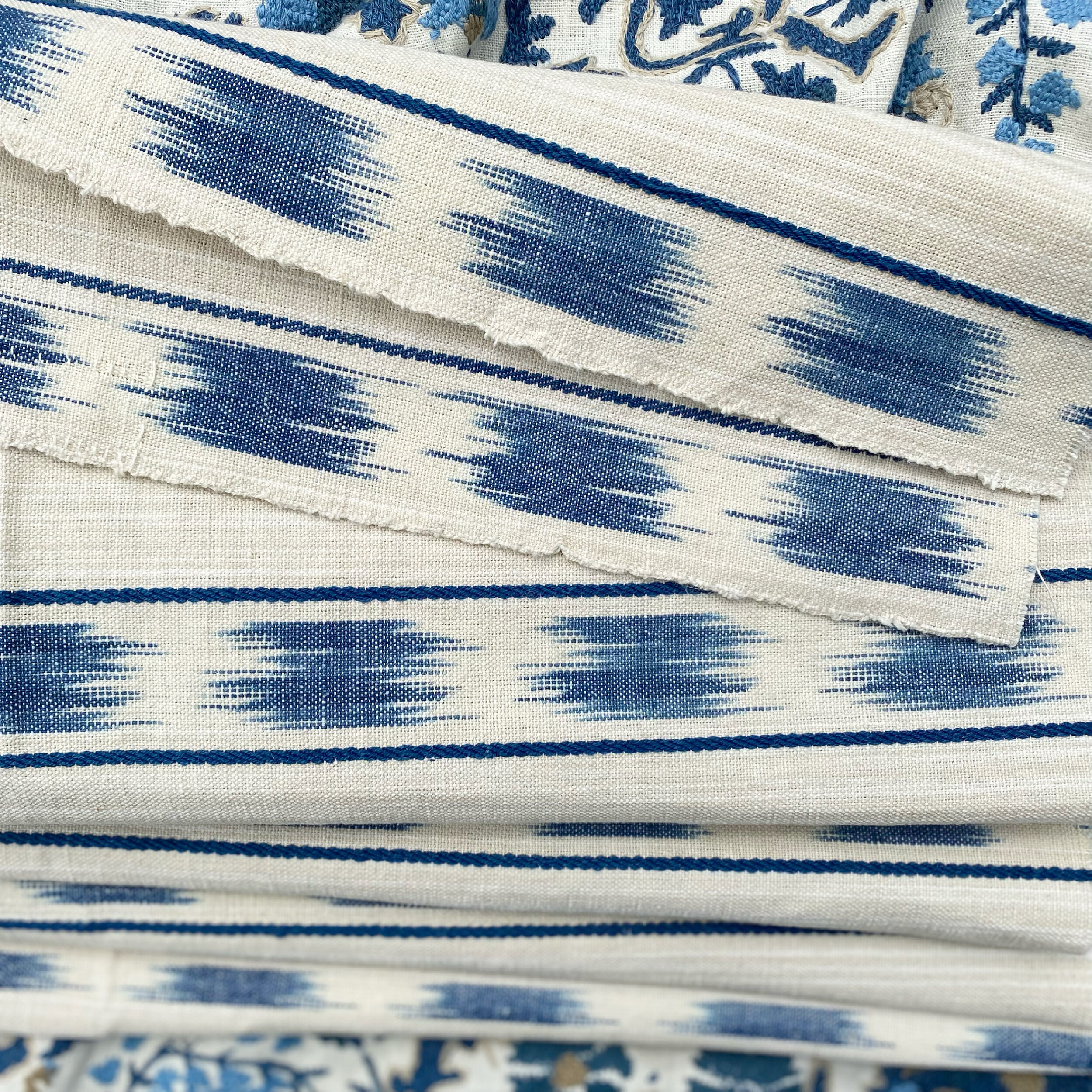Mahala Textiles
We’ve combined our love for natural materials, craftsmanship, colour and pattern to create a range of textiles for upholstery and soft furnishings. Inspired by antique textiles and tiles, intricate carvings and hand painted murals, the range includes timeless, hand block printed linens, woven ikats and embroidery. As much as we love pattern and colour, we didn’t just want to create pretty fabrics. We've put environmental, social and economic sustainability at the forefront of our new textiles range, and this journal issue is here to explain why.
Conventional Cotton
The global average water footprint for producing 1kg of cotton is 10,000 litres. That’s around 2,700 litres of water to produce 1 cotton T-shirt, or in other words, enough to provide one person with 900 days of drinking water.
In most regions of the world, over 70 percent of freshwater is used for agriculture. By 2050, feeding a planet of 9 billion people will require an estimated 50 percent increase in agricultural production and a 15 percent increase in water withdrawals.
An example of this devastation is the destruction of the Aral Sea, one of the planet’s biggest environmental disasters - caused entirely by humans. Once the world’s fourth largest lake, the Aral Sea in Central Asia has been losing water for half a century — ever since Soviet engineers began diverting the two rivers that sustain it, the Amu Darya and Syr Darya, in order to grow cotton in the desert.
Now the Aral Sea is all but sand, an increasing number of dust storms blow salt, pesticides, and herbicides into nearby towns causing a variety of respiratory illnesses including tuberculosis.
Cotton growing is also directly implicated in the degradation of many other large-scale ecosystems including the Indus River Delta in Pakistan, the Yangtze and Yellow Rivers in China and the Murray-Darling Basin in Australia. Without a new mindset and approach to how we value water, the Aral Sea is a harbinger of what’s to come in other parts of the world.
“It is clear that we need to reduce farming’s wasteful use of water, its overuse of chemicals hazardous to people and wildlife, its soil erosion and pollution, and its slash and burn appetite for natural habitats. Only then can we feed and clothe ourselves without worrying about tomorrow’s harvest.”
Organic Cotton
In 2014, Textile Exchange commissioned a Life Cycle Assessment on organic cotton and found significant, measurable environmental benefits compared to conventional.
Reduces environmental footprint
No toxic chemicals are used in the growing of organic cotton. It doesn’t damage the soil, has less impact on the air, and uses 88% less water and 62% less energy. Conventional cotton uses about 16% of the world’s insecticides and 7% of pesticides.
A model for the future
By 2025, two-thirds of the world’s population may face water shortages. But organic cotton is 80% rain-fed, which reduces pressure on local water sources. The absence of chemicals also means that water is cleaner and safer. Cotton is often grown in water-scarce areas using irrigation and it takes 2,700 liters of water to make a conventional cotton t-shirt.
Fair price for sustainability
When you buy organic cotton you are investing in water conservation, cleaner air, better soil and farmer livelihoods. The price for organic cotton is therefore sometimes, but not always, higher. However, with demand on the rise, more choices will become available.
Promotes safe work & better livelihoods
Growing organic cotton keeps farmers and their families safe. They are not exposed to toxic chemicals in the field or through their food and water supply. It also means farmers grow more than one crop which supplements their food and income.
Better Cotton Initiative
“Persuading governments and business to change the context within which farmers live and work to one that is sustainable, environmentally, socially and economically, is one of the biggest challenges we face in the 21st Century.”
The Better Cotton Initiative (BCI) is a not-for-profit organisation that exists to make global cotton production better for the people who produce it, better for the environment it grows in and better for the sector’s future. Through BCI and its Partners, farmers receive training on how to use water efficiently, care for the health of the soil and natural habitats, reduce use of the most harmful chemicals and apply decent work principles. BCI Farmers implementing this system are licensed to sell Better Cotton.
The Better Cotton Initiative provides farmers with the skills and knowledge to meet and continuously improve their performance against the Better Cotton Principles and Criteria, improve the sustainability of their farms and gain a BCI license. Once licensed, farmers are able to sell their cotton as Better Cotton, increasing the supply of more sustainable cotton available on the global market, and linking farmers with a growing demand for more sustainable raw materials.
The Better Cotton Principles and Criteria lay out the global definition of Better Cotton, by upholding the following seven principles:
BCI Farmers minimise the harmful impact of crop protection practices
BCI Farmers promote water stewardship
BCI Farmers care for the health of the soil
BCI Farmers enhance biodiversity and use land responsibly
BCI Farmers care for and preserve fibre quality
BCI Farmers promote decent work
BCI Farmers operate an effective management system
By adhering to these principles, BCI Farmers produce cotton in a in a way that is measurably better for the environment and farming communities.
Linen, a super fibre
A super fibre that far outweighs conventional cotton both environmentally and ethically is linen, produced from the flax plant. Flax has been with humankind long before Europeans’ discovery of the Western Hemisphere. Linum angostifolium, the wild ancestor of flax, can be found from the Black Sea to the Canary Islands. Linus usitatissimum (meaning “of greatest use”), is the oldest cultivated fibre plant, with evidence of its growth and use dating back to the fifth millennium BC in both Mesopotamia and Egypt.
Flax grows well in cool, humid climates and does best in soil that’s moist and well-plowed, like those of Europe. It is thought that Belgian flax is the finest quality flax in the world, but it is also grown in Denmark, the Netherlands, Poland, Austria, France, Italy, Spain, Switzerland, and the British Isles. Flax grows well with very little water (just rainwater and a little humidity). Only 6.4 liters of water are needed to produce a linen shirt—compared to 2,700 liters for a non-organic cotton shirt. Non-organic flax needs few pesticides or fertilisers.
What we’re doing
We have printed our first collection on natural linen with water based pigments, and for durability, our woven stripes and embroidery contain Better Cotton.
We believe every person working in the supply chain should have equality, a safe place to work, and the means to support themselves and their families, free of bribery and corruption, and sustainable methods that keep the environment intact for future generations. Our supplier is a member of Sedex, a leading, global sourcing platform for building these ethical supply chains.
When you choose our textiles, you will also be funding vital water projects across the world through our partnership with Charity: Water. Private donors fund their operational costs, meaning every penny goes directly where it’s needed. Each project is proven with photos and GPS coordinates which we share through The Mahala Foundation.
Why water?
Today, 2.1 billion people do not have a reliable water supply in their homes (Ritchie & Roser, 2019), and by 2025, 1.8 billion people are expected to endure absolute water scarcity (UN, 2015). Every year, almost 300,000 children die from water-related diseases. This corresponds to a child dying every other minute (Water.org, n.d.). Two billion people only have access to excrement-polluted drinking water, and every year, 480,000 people die from diarrhoea caused by contaminated water (WHO, 2019a).
Every year, one million people die from diseases related to water, sanitation and hygiene (Water.org, n.d.). Water-related diseases impacts developing countries the hardest; especially children under the age of five. 30% of the deaths of children in developing countries are caused by lack of clean water and sanitation (OECD, 2011, p. 14).
The countries where water poverty is the worst and water usage is the lowest are Mozambique, Rwanda, Haiti, Ethiopia, and Uganda, which are just some of the places The Mahala Foundation will be helping through Charity : Water, every time you choose one of our fabrics for your home. Join The Thread below to receive updates on our 2021 launch.
“It’s not true that we don’t have the resources. We need to recognise that we’re all in this together and our priotries must reflect this.”











